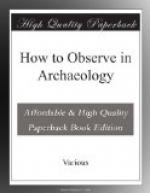Characteristics. Flourishing period of Assyrian art and writing (for details see the archaeological books, which are very full on this period). Mounds may be known by the occurrence of fragments of granite or basalt bowl-querns, often with feet; pieces or whole vases of the multi-coloured opaque glass usually called ‘Phoenician’ (which are already found in the preceding period); alabaster pots; straight-sided cylinder seals (see XIV, Fig. 6); Syrian conical seals of steatite (XIV, Fig. 7); small and rude clay figures of deities, such as Ishtar or Papsukal (the guardian of buildings), and animals, such as horses, sheep, doves, ducks, &c.; bronze pins, often with birds on the heads; baked clay tablets of the fine Kuyunjik type (see XV, Fig. 12; script, Fig. 17); pottery lamps with long protruding curved nozzles; pottery vases simple and undecorated save by incised lines, as for many centuries past (for types see XIV, Figs. 9 a b c d); light-blue glazed ware introduced from Egypt towards end of period; polychrome glazed ware with designs of rosettes, chevrons) &c., somewhat earlier; large pots without feet common for storage of grain and oil, sometimes for tablets: mouth often closed with a brick. Stone pithoi are also found. Vertical drains or sinks, made of a number of pottery cylindrical drums, fitting on top of or into one another, are found everywhere on town-mounds of this period; visitors should avoid tumbling into them, as they are often open or only covered by a very thin crust of earth. Usually they are perforated to allow of soaking into the surrounding earth, and are, when excavated whole, generally found capped by, a beehive-shaped perforated cover. Sometimes these drains were made of old pots with their lower parts broken off, and fitted into one another. Secular buildings were of burnt brick; sacred buildings usually of crude brick, from religious conservatism. Crude bricks nearly always oblong; burnt bricks square (14 ins.) or oblong (9x6x3 ins.). The burnt brick of Nebuchadnezzar’s time is extraordinarily fine and hard, and the bitumen-mortar so finely spread as to be almost invisible (Babylon). Walls of this reign have a rock-like solidity and tenacity that should make them easily recognizable. Those of immediately preceding reigns show the bitumen far more clearly, and the bricks are usually not as finely made as Nebuchadnezzar’s; at Babylon the latter’s work is thus at once distinguishable from that of Nabopolassar. A typical brick-inscription of Nebuchadnezzar is illustrated above, XV, Fig. 11. It is in the revived archaic script, always used for this purpose by the late Babylonian kings. Use of coloured glazed brick is characteristic of period; often relief figures of animals are made up of glazed bricks each specially moulded for its proper position and numbered (Ishtar Gate, Babylon). Royal palaces were often decorated with reliefs depicting conquests, &c., carved on slabs of alabastrine marble placed along the brick walls, with great statues of human-headed




